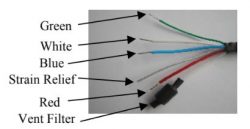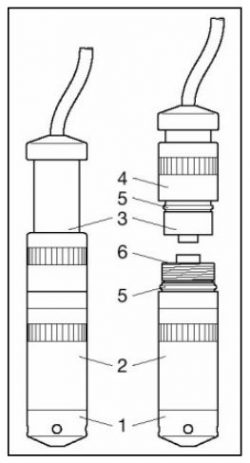Sensor probes with removable submersible signal cable for measuring liquid level. These sensor probes can be easily replaced without the need to remove the installed cable assembly or break connections to cable junction boxes and termination enclosures.
Products
 LMK 858 Plastic Submersible Liquid Level Sensor with Removable Cable - Chemical resistant liquid level sensor with detachable signal cable for measuring quantity of aggressive media such acids and alkalis and sludge in tanks located outside of factory buildings.
LMK 858 Plastic Submersible Liquid Level Sensor with Removable Cable - Chemical resistant liquid level sensor with detachable signal cable for measuring quantity of aggressive media such acids and alkalis and sludge in tanks located outside of factory buildings. LMP 308 Removable Waterproof Cable Connection Water Level Sensor - Groundwater, tank & reservoir water level detachable submersible cable hydrostatic liquid level sensor for multiple municipal water level measurement locations.
LMP 308 Removable Waterproof Cable Connection Water Level Sensor - Groundwater, tank & reservoir water level detachable submersible cable hydrostatic liquid level sensor for multiple municipal water level measurement locations.
The cable supplied with submersible liquid level sensors is relatively expensive when compared to other types of sensor cable since it has to be resistant to the liquid it is placed in, strong enough to withstand external damage, include materials to prevent cable stretch , and incorporate a vent tube to provide an ambient pressure reference in the case of hydrostatic devices.
 In addition to the complexity of submersible cable, a longer length of cable is often required to run from the bottom of a deep tank to the surface of the liquid, and from there to a cable junction box. In these cases it is not unusual for the cable to be a major part of the sensor cost, and in some cases it will be more than half the overall cost of the sensor.
In addition to the complexity of submersible cable, a longer length of cable is often required to run from the bottom of a deep tank to the surface of the liquid, and from there to a cable junction box. In these cases it is not unusual for the cable to be a major part of the sensor cost, and in some cases it will be more than half the overall cost of the sensor.
Since submersible liquid level sensors are immersed in a wide range of different media types, many of which will degrade the measurement performance as residue builds up on the outer surfaces. Maintenance and cleaning the sensor can be inconvenient if conducted in-situ, and some sensors maybe installed in inaccessible locations, making it necessary to remove them. If the sensor can be easily detached from the cable, then this can save a lot of time, preventing the removal of cable trunking, clips and electrical connections.
 Submersible seals are very difficult to achieve, and this is why many submersible sensors do not have removable cables, because it is easier and lower cost to ensure a high integrity seal if the cable cannot be removed. However due to the long lengths of cable and variety of locations where submersible liquid level sensors are installed, there is always the risk that a cable may get damaged during installation or operation. If the cable can be simply removed from the sensor, it is then only necessary to replace the cable and save on the cost of the sensor.
Submersible seals are very difficult to achieve, and this is why many submersible sensors do not have removable cables, because it is easier and lower cost to ensure a high integrity seal if the cable cannot be removed. However due to the long lengths of cable and variety of locations where submersible liquid level sensors are installed, there is always the risk that a cable may get damaged during installation or operation. If the cable can be simply removed from the sensor, it is then only necessary to replace the cable and save on the cost of the sensor.
Advantages
Advantages of submersible liquid level sensors with a removable cable connection are:
- Save on sensor replacement cost if cable is damaged
- Save on cable replacement cost if sensor is damaged
- Remove sensor from installed location for maintenance and cleaning without disturbing cable installation above the liquid surface
- Reduce cost of spares stock by interchanging cable lengths and level ranges
- Repurpose sensor for different liquid media by changing the cable type
Disadvantages
Disadvantages of of submersible liquid level sensors with a removable cable connection are:
- Higher cost compared to the equivalent sensor with a permanently sealed submersible cable termination
- Care must be taken to disconnect and reconnect the submersible seal as described in the manufacturers operation manual to prevent seal damage or a poor seal.
- Larger size housings to accommodate the submersible connection components restricts installation into smaller diameter tubes and boreholes.
Checklist for detachable cable submersible liquid level sensor probe requirements
Define your detachable cable submersible liquid level sensor probe requirements using this checklist:
- Liquid type?
- Density of liquid?
- Viscosity of liquid?
- Max/Min level?
- Vented or pressurised liquid?
- Output signal?
- Cable length?
- Temperature range?
- Diameter limitation?
- Hazardous area?
- Lightning protection?
